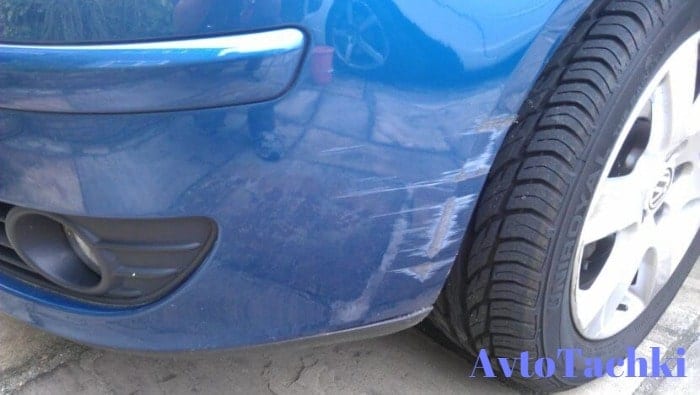
How to remove scratches on a car
Content
- Removing scratches on a car
- What is LCP?
- Where do scratches come from?
- Types of scratches
- Troubleshooting Methods
- Choice of polishing agent
- How to remove small scratches on varnish
- How to remove scratches from paint
- How to remove scratches on glass
- How to remove scratches from plastic
- How to remove scratches from headlights
- How to remove a scratch from a car body without painting?
- Tips for removing scratches from partial body paint
- General recommendations for removing minor scratches on a car
- How to remove medium depth scratches on a car?
- How to remove deep scratches and chips
- How to prevent defects
- Video: ways to remove scratches on a car body without painting
Removing scratches on a car
No matter how carefully you treat your car, scratches will inevitably appear on its body. The reason may be branches, dirty rags of car washes, small stones that bounced off the wheels - all that the driver can’t influence. The only way to avoid them is simply not to use the vehicle. But was the car bought in order to gather dust in the garage?
Fortunately, car owners, there are ways to eliminate such damage at home, which will not "hit" the budget. In this article we will talk about the most popular and effective ones.
What is LCP?
First you need to figure out what the paintwork of a car is. Everyone knows that this is the coating of the car body with paint and varnish. In addition to providing aesthetics to the vehicle, the paintwork system is designed to prevent premature destruction of the metal due to corrosion.
The paint system includes the following categories of layers:
- Primer The primer includes substances that are resistant to temperature extremes and slight deformations. Among this category, there are acrylic (used in the repair and restoration of the body), epoxy (have anti-corrosion properties) and acid (used before painting the body and are designed to prevent metal oxidation).
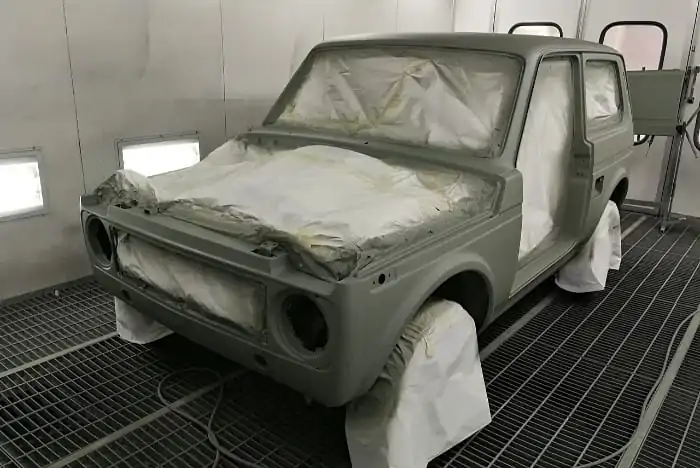
- Intermediate. This layer is responsible for body color. Acrylic enamels are distinguished among auto enamels (they dry quickly, do not shrink, are resistant to mechanical damage, and do not deteriorate when changing atmospheric conditions), alkyd (budget option, polishes worse, it is difficult to achieve a mirror effect; auto painters recommend them for local work), metallic the composition includes aluminum powder, giving the body an original shine). Some types of paints do not require the use of varnishes. Special varieties of paints have been created for rims and bumpers.

- The coverslip. The purpose of the varnish coating is to protect the base layer from ultraviolet rays and the aggressive effects of atmospheric conditions. There is a huge variety of auto lacquers. The list includes acrylic (they require adherence to the application technology, dry quickly), cellulose (practically not used for repairs), glyphthalic (composed of synthetic resins providing a protective layer of elasticity), polyurethane (they are resistant to brake fluid, gasoline and acid ), acrylic polyurethane (two-component varnishes with the properties of acrylic and polyurethane analogues).
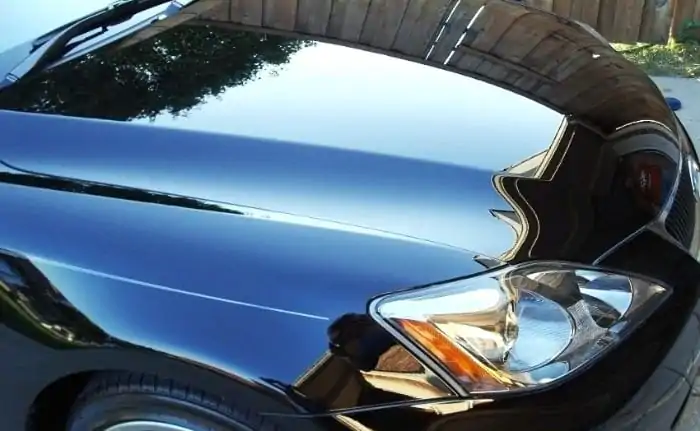
For more information about the functions of the paintwork, see this video:
Each manufacturer at the stage of processing the body with protective equipment uses different materials, which may differ from their analogues in chemical composition. The longer the coating will be, the less corrosive the car body will be affected.
That is why every motorist needs to monitor the cleanliness of his car, and be careful about the appearance of scratches on the paint.
Where do scratches come from?
When the varnish is destroyed, the car body loses its original shine. Due to the violation of the protective layer, ultraviolet rays freely reach the paint layer and change its color over time. The thinner the layer of varnish becomes, the greater the exposure to the weather. Over time, microcracks and bundles appear on it. If you do not care for the paintwork of the car, these cracks become more expressive and can lead to chipped paint.
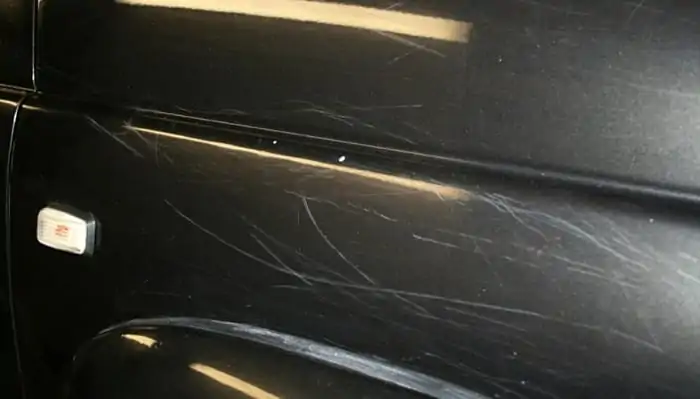

In addition to the natural aging process of the protective and decorative layer of the body, scratches on it can appear for the following reasons:
- Dirt, dust, stones. While driving, a lot of small particles are hit on the car body (they can be thrown out from under the wheels of an oncoming or ahead vehicle), which scratch the varnish or form chips.
- Sloppy driving. An inattentive driver may inadvertently catch the gate support when leaving the yard or during a parking push a nearby car. When traveling on a picnic in the forest, a car can catch a branch.
- Inaccurate washing. Some motorists save on basic things. For example, they use dirty rags, sponges to wash the car and do not use car shampoos, thinking that this is a waste of money. In fact, soapy water eliminates the abrasive effect, and special rags (for example, wet suede or microfiber) easily collect microscopic particles, so that after washing there are no scuffs on the body.
- Attackers can specifically scratch the car. A cat or a bird can go over it.
Here is another option where scratches can appear on the paintwork:


Watch this video on YouTube
This is actually not a complete list of the causes of scratches. It all depends on the operating conditions of the machine and the situations that occur on the roads. As you can see, not all causes can be prevented.
Types of scratches
Since scratches can be of a different nature, the methods for removing them can also be different. The same can be said about scratches on different types of surfaces, such as glass, plastic or paintwork.
Glass scratches are:
- Small scratch (depth up to 0.3 mm). Such damage is almost imperceptible, and they are more often called scuffs. For such damage, the matte surface of the glass is characteristic. If this is a windshield, then such damage will interfere with the view for the driver, especially at night with the headlights of oncoming traffic. The use of worn-out wipers, wiping the glass on a dry one (sand acts as an abrasive) leads to such damage to the glass.
- Deep scratch (more than 0.3 mm deep). They are visible even in daylight. Similar damage often appears on the windshield when the metal part of the wiper scrapes against the glass. It can be a single scratch or in the form of a web.
For scratches characteristic of the paintwork, there is such a classification:
- Cobwebs are small abrasions that are hardly noticeable, especially from afar. Such damage affects only the varnish layer, so polishing is sufficient to eliminate them.
- Small scratches are more significant grooves that can be noticeable (depending on their depth, width and length). Such a scratch may affect several layers of paint, but does not reach the primer layer.
- Deep scratches - damage that clearly affected the primer layer, but did not damage it to the metal. Such damage rarely causes corrosion, but if it is not repaired, then moisture will inevitably begin to act on the metal, and corrosion under the ground will form.
- Chips are a chipped piece of paint. Such damage often appears during impacts with metal deformation or poor-quality bodywork before painting the car.
- Corrosion in a scratch is damage to all layers of paint, including the primer. Since access to air and moisture has been opened, the metal begins to oxidize, which sooner or later will lead to more significant damage to the body part.
Troubleshooting Methods
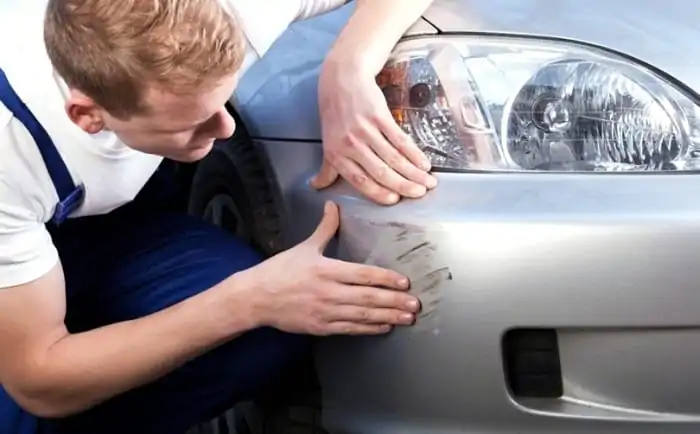

Since the nature of damage to the paintwork can be different, the methods for their elimination also vary. Among all the methods, three main ones can be distinguished:
- Polishing. It is enough if the damage depth is within the varnish coating.
- Painting and polishing. This method is used for deep scratches. To do this, paint is applied to the damaged area, and polished after drying.
- Abrasive polishing. It is used in the presence of numerous small scratches. It should be noted that during the procedure a thin layer of varnish is removed, so you should not use this method constantly.
In many car service centers, after repair work, the car body is covered with wax or liquid glass. These products provide additional protection against moisture and sunlight.
Here are answers to the most common questions about polishing a car:


Watch this video on YouTube
Choice of polishing agent
Modern manufacturers provide a huge selection of tools for polishing the car body. Conventionally, they are divided into two categories:
- Protective. Their purpose is to protect the paintwork from exposure to ultraviolet rays, they collect less dust due to the statics of the body. According to the principle of action and composition, there is a great variety of them, so before using them, you should consult with specialists.
- Abrasive Such polishes are designed to eliminate scratches of varying degrees of complexity. They differ in grain size: coarse-grained, medium-grained, fine-grained and microabrasive.
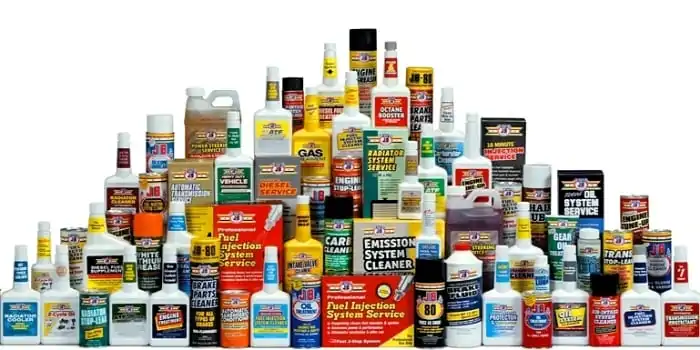

Among the protective polishes there are synthetic and organic. The advantage of the first category is that such products remain longer after application. They may contain substances for the effective removal of oil and bitumen stains. Synthetic protective polishes, unlike organic ones, more effectively eliminate micro-scratches from varnish, and give the car's color the same freshness. They are mainly used after the main polishing.
Abrasive products have a pasty or liquid structure. The former have a fatty base, while the latter have a silicone (or water) basis. When treating deep scratches, several types of abrasive substances should be used - gradually reduce the graininess as the area is treated (before using the following product, the remaining paste must first be removed and then a new one applied).
For a more detailed overview of abrasive pastes, see the following video:


Watch this video on YouTube
To date, there are universal means for polishing the body. One of them is 3M paste. It also includes organic and synthetic substances, which expands the range of protection of the paintwork.
Recently, manufacturers are developing alternative means for protective treatment of the body. For example, one of these polishes is NanoWax. It is used not only for processing plumage cars, but also suitable for glass and plastic elements of the machine. Another protective tool that is gaining popularity is the "liquid glass".
How to remove small scratches on varnish
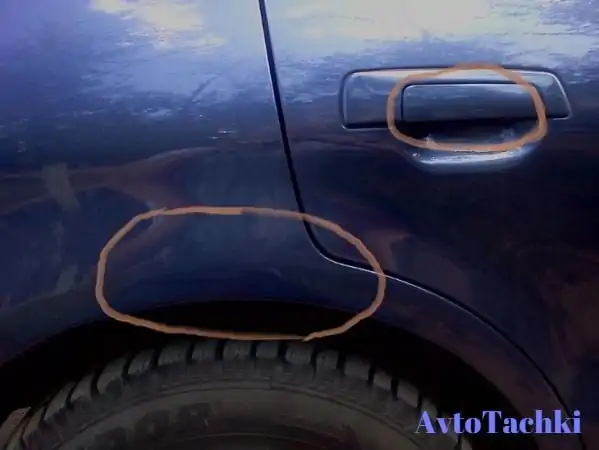

Minor scratches on the machine can be fixed quickly and easily. To do this, you only need a finely abrasive paste. However, before proceeding directly to the removal of scratches, you need to perform preparatory work.
First, thoroughly clean the car of dirt. To do this, wash it with a car shampoo and dry it. It is advisable to put the vehicle in the shade so that it does not heat up in the sun. After that, take masking tape or a simple adhesive tape, and glue over the damaged areas to work only with them, without touching the rest of the body.
Now you can proceed to the removal of scratches. To do this, apply a finely abrasive paste to them, and begin to overwrite them with smooth circular movements. Terry or microfiber fabric can be used. When the polishing agent is evenly distributed, the rag should be replaced with a dry one and continue.
The procedure should be repeated until the defects have completely disappeared.
Wax polish
This is a wax based product. It is used in the treatment of the car body after washing to create a water-repellent effect. Wax will fill small scratches, and due to its transparency, it will create the effect of full elimination of scuffs.
The disadvantage of this method of eliminating small scratches is the fragility of protection. After a couple of washes, and the car needs to be processed again. The number of washes that the product can withstand depends on the polish itself, but in any case this effect is short-lived.
Polishing machine + abrasive paste
This combination provides a longer effect compared to the previous one. Due to the presence of small abrasive particles in the polish, small scratches are eliminated. It is worth considering that this method applies only to those scratches that affected only the varnish, but did not touch the paint.
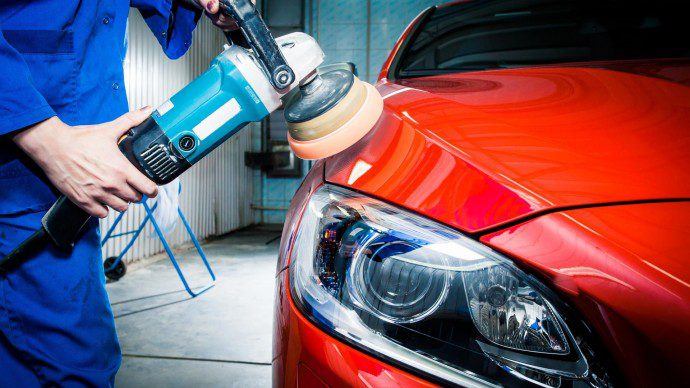

Polishing the damaged part of the body can be done independently, and for this you need to purchase:
- A polishing machine (a drill or a grinder will not work, because you need to set a small speed);
- fine abrasive paste;
- Sanding paper with 2000 grit;
- Napkins;
- Atomizer for clean water.
Before you start polishing, the body must be washed well. When performing work, the treated area should be clearly visible so that you can monitor the achievement of the desired effect. The car must be dry, as moisture fills in small scratches, and it seems that they are not there.
Treat the scratch itself with sandpaper, pre-wetting it with plenty of water. After processing, this part of the body is wiped dry with napkins. A small amount of polishing paste is applied to the grinding wheel and the area is polished at low speeds. Do not stop in one area, and do not bring the speed to the maximum, so as not to damage the paintwork.
To ensure that the polished area does not differ from the rest of the paintwork, the movements must be smooth and must be alternated from left to right and from top to bottom. It is important not only to process the scratch itself, but also some area near it, so that the treated surface is as even as possible.
When polishing the body, it is necessary to frequently rinse the surface to be treated with clean water, and remove plaque from the wheel. Polishing should be carried out until a scratch is visible on the surface.
How to remove scratches from paint
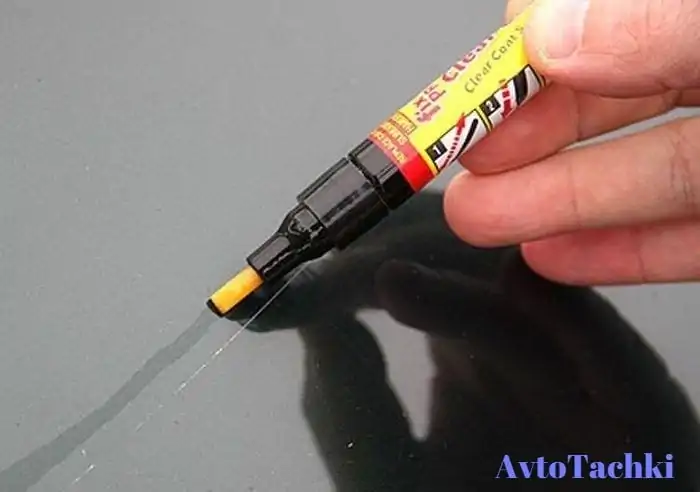

More serious defects are removed with a restoration pencil. This is a simple and effective way to eliminate mid-depth scratches.
Before starting the main work, the car should be washed from dirt and dust, as well as degreasing damaged areas in order to eliminate the possible presence of extraneous chemical compounds.
Next, you need to carefully cover up the defect, trying to minimally hurt entire areas of the body. When everything is ready, let the paint dry for a day and rub the surface to get rid of the traces of the pencil. To do this, use a fine sandpaper or a rubber sponge. The main thing in this process is not to rush anywhere.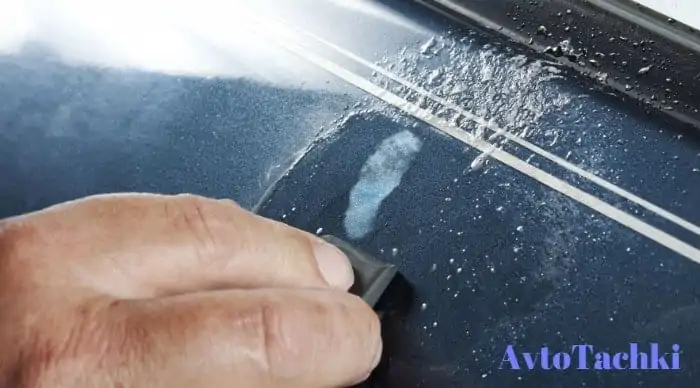

The resulting damaged area is removed with a simple polishing agent. Apply it and rub it in a circular motion, using a terry cloth. As a result, the defect will completely disappear, and the body will again become smooth and shiny.
How to remove scratches on glass
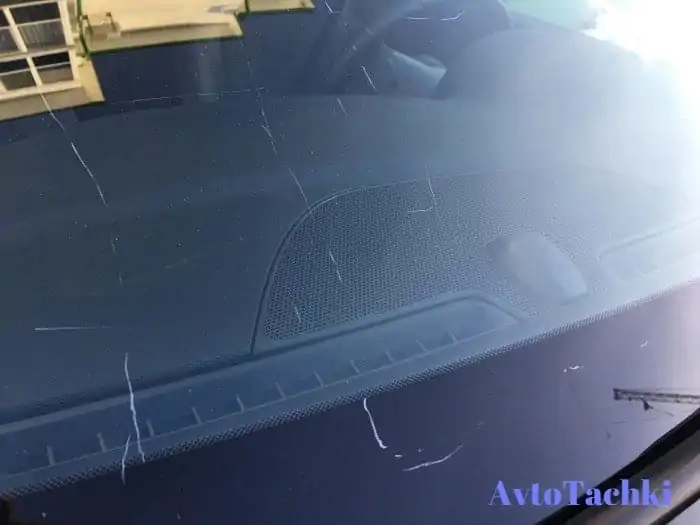

Damage to the glass is not only a matter of appearance, but also a matter of safety, because scuffs and a spiderweb worsen the driver's view. The most effective way to get rid of them is to contact specialists. However, if you want to save, you can do everything yourself.
To eliminate defects on the glass, a special abrasive paste is used. The most effective is a brown polish - based on cerium oxide.
Wash first and wipe dry the area to be worked on. On the back of the glass, we recommend making marks to indicate where the defects are. Thus, you will not miss a single damaged area, because in the process of mashing, it will be almost impossible to discern minor scuffs.
The next step is polishing. Rub the paste thoroughly into flaws to fill them as much as possible. To simplify the work, you can perform these actions not manually, but put on a special nozzle on the drill. Do not forget to take breaks so as not to overheat the glass.
Polishing can take from 30 to 60 minutes. Continue until the result suits you.
Small scratches and traces of the wipers will go away completely, and deeper ones that cling to the nail will become less pronounced and smoothed out.
How to remove scratches from plastic
Scratches on a car occur not only outside, but also in the passenger compartment. One inaccurate action may be enough to leave a long and unpleasant mark on the plastic.
There are two ways to remove such defects.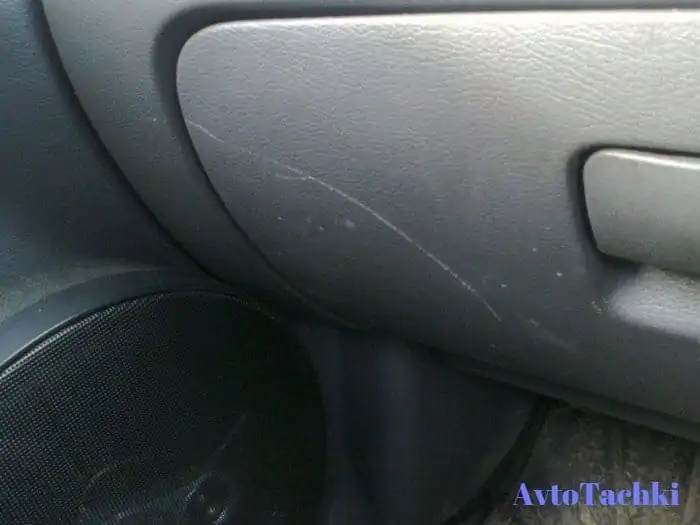

The first is more expensive and time-consuming, using special restorers. A lot of such products are sold in car dealerships - in the form of aerosols, sprays, etc. However, they have a similar operating principle. Due to their good penetrating ability, they effectively fill in scratches, and the polish included in their composition returns the plastic part to its original appearance.
Before using such tools, the work area should be washed and degreased, and in especially severe cases - primed.
The second method will allow you to quickly repair small, and significantly tighten deep scratches on the plastic in the car. You will need a building hair dryer. Set the device to a temperature of 500 degrees Celsius, and at a distance of 30 centimeters, bring it to the place to be processed. As a result, the defect will be “magically” delayed. If you don’t have such a device, you can replace it with a simple lighter.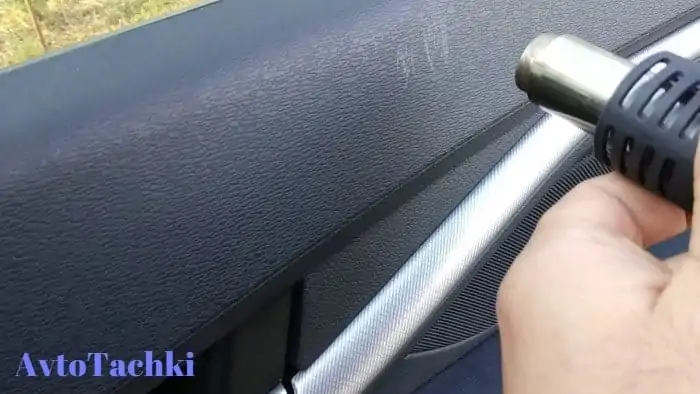

The main thing here is to be careful so as not to overheat the plastic. Otherwise, the part may melt and will have to be completely replaced.
For more information on how to remove scratches from plastic, read separate article.
Plastic restorers
Different manufacturers offer buyers plastic restorers in different forms: spray, milk, polish or aerosol. A feature of these funds is good penetrating ability. Due to this property, they are successfully used to fill small scuffs and scratches on plastic.
Each product has its own method of use, so in each case there is an individual instruction for use printed on the package. Basically, such products must be applied to dry and clean elements. they are allowed to dry, and then the treated surface is polished with microfiber or a dry cloth.
Hair dryer or lighter
If you need not only to refresh the plastic elements in the car interior, but to eliminate minor damage, a more budgetary option is to use heat treatment. To do this, you can use a lighter. True, in this case, instead of restoring the plastic, it can be even more damaged. It is much more practical to use a building hair dryer.
It is necessary to process the surface by gradually raising the temperature on the hair dryer. Do not direct the flow of hot air to only one part of the plastic part. It is better to make smooth movements from side to side in order to smooth out the thermal effect boundary.
When using this method, keep in mind that some scratches cannot be completely eliminated, for example, if they are very deep or part of the plastic has broken off.
How to remove scratches from headlights
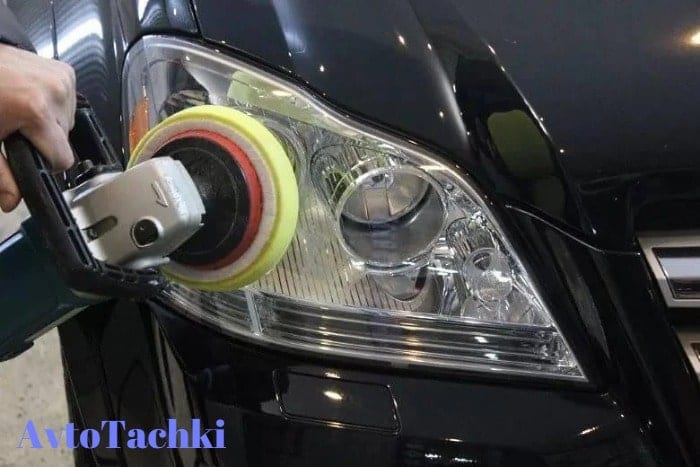

Scuffs and defects on headlights are eliminated by the same principle, as on glasses. Garage craftsmen often get rid of the clouding with ordinary toothpaste. However, it’s better not to risk it, and purchase a special set for polishing, because it includes all the necessary components.
The use of such sets is not difficult.
- It is necessary to wash and dry the treated surface.
- Stick a masking tape on the bumper, doors and other adjacent parts of the body to protect them from the ingress of mortar.
- The glass surface is sanded with a damp sandpaper.
- Optics is processed by coarse-grained, then fine-grained polish.
- The headlight is cleaned and washed, after which a layer of UV varnish is applied to it.
After completing the procedures, the car cannot be used for a couple of hours until the varnish is completely dry. Full polymerization takes place during the day; washing the machine at this time is prohibited.
How to remove a scratch from a car body without painting?
If the scratch on the car body is shallow, then it can be repaired without painting the car. It is extremely difficult to perform high-quality painting work on your own, and the services of a specialized center are often expensive.
To remove small abrasions and small scratches that appear on the car body, for example, during the winter period, you can get by with the usual polishing of the body with a finely abrasive paste. But in case of deep damage, and especially in the presence of chips, it is impossible to keep the body metal for a long time without paintwork.
Tips for removing scratches from partial body paint
Partial painting of the car body after removing traces of damage will be required if the scratch is serious, but not extensive. There is no need to repaint the entire car in such cases. The use of paint and varnish is advisable if the scratch has affected the metal. These products can be purchased at auto parts stores. They are small bottles of paint of the desired color.
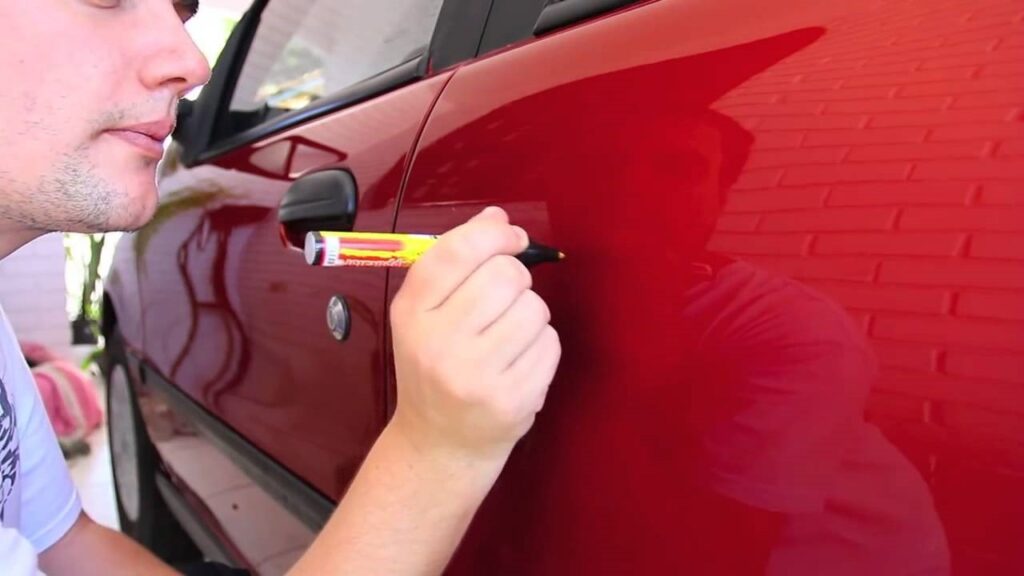

They have a small brush in the lid, with which you can easily apply a small amount of paint to damage. But before using paint, exposed metal must be treated with a rust converter (even if corrosion is not visible).
In more advanced situations, for example, if the metal was damaged by through corrosion, then in addition to removing rust and stopping the oxidation process, you will also need to use automotive putty. After restoring the base, a primer and several layers of native paint or a selected analogue are applied to it. Upon completion of these works, the painted surface must be protected with varnish and the area polished.
General recommendations for removing minor scratches on a car
If it was decided to independently eliminate minor scratches that appeared on the body of the car, then here are some recommendations for doing this work:
- The room in which the work is carried out must be dry and without drafts;
- It is better to carry out paint and varnish and polishing work indoors, and not outdoors in a calm time. It is impossible to completely eliminate the possibility of wind. Even a small breeze can raise fine dust, which can greatly disrupt the technology;
- Before starting to process the damaged area with polishing paste, this body part must be prepared - washed and dried;
- Before local application of paint, the surface must be degreased, for example, with white spirit;
- Any body treatment agent has its own instructions, which indicate the subtleties of working with the substance.
How to remove medium depth scratches on a car?
In this case, polishing will not help, because not only the varnish layer was damaged, but already the paint. Even if the scratch can be repaired, the visually treated area will be different due to the lack of a varnish layer.


To repair a deep scratch, you can use a colored pencil to restore the paintwork. These restoration pencils are based on acrylic resins, which have excellent adhesion. If the car owner will use these materials, then the instructions for use must be carefully followed.
As in the case of grinding and subsequent polishing of the body, the surface to be treated must be degreased, well cleaned and dried. Often, the reducing agent is very easy to apply. In many cases, the restoration pencil has a small brush.
If there is no certainty that the work will be done carefully, then the treated area can be pasted over with masking tape. Before going to the sink, it is necessary to wait a certain period of time after the restoration work. It depends on the manufacturer and their recommendations. Some substances can withstand contact with water already half an hour after the treatment of the body, and in some cases after only 10 days.
How to remove deep scratches and chips
If the scratch on the machine has reached metal or is chipped, you will need a special restoration kit. As a rule, it includes all the necessary tools - anti-corrosion and conventional primers, degreaser, paint and varnish.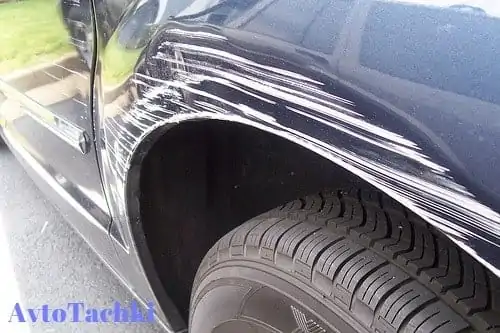

The principle of action is as follows:
- Rinse and dry your car.
- Using sandpaper, clean the rust, if any.
- Apply anticorrosive primer to the surface and allow time for it to dry. Following is applied ordinary soil, which levels the surface and prepares for painting.
- The damaged area should be painted over twice. First apply the first coat of paint, and when it dries - another.
- Apply clearcoat.
Thus, you will not only improve the appearance of your vehicle, but also extend its service life, saving the body from the development of corrosion. Serious defects on the body should be eliminated as quickly as possible, otherwise the repair price may increase at times.
How to prevent defects
A well-known saying goes: "Better to warn than to heal." Based on this principle, instead of frequent restoration work, it is necessary to carefully operate the car and apply protective equipment to handle the body.
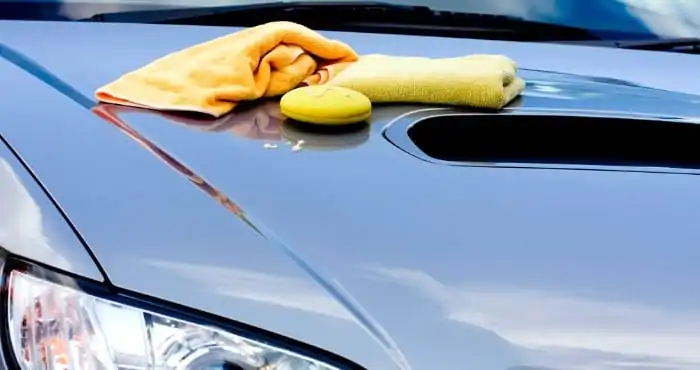

Standard precautions include:
- careful care of the paintwork (do not rub it with dry rags with dry rags, do not handle the body with aggressive agents containing acetone and similar substances);
- accurate riding (to be careful when parking and driving near overall obstacles);
- use of protective equipment (wax coating to protect against dust and moisture).
Compared to repainting a car, the use of protective equipment will be much cheaper, so do not ignore minor scratches on the body. If there are doubts about the quality of work, you should seek the help of specialists.
And here is another short video about car paint care:


Watch this video on YouTube
Video: ways to remove scratches on a car body without painting
Here is a short video on how to repair scratches yourself without painting the entire car:


Watch this video on YouTube
Common questions:
What if i scratched my car? If only a layer of varnish is touched (the nail does not cling to the damage), you can polish with polish. If the damage has exposed the metal, you should contact an auto-painter.
How to polish scratches on a car? Minor scratches (not visible after washing) can be hidden with body wax polish. Deeper damage to the lacquer coating is removed with an abrasive paste and a polishing machine.
How to remove scratches on a car? A scratch that has reached the paint layer is first removed with a restoration pencil (composed of a quick-hardening acrylic resin), and then with polishing. If the primer is damaged or chipped, prime, paint and varnish.
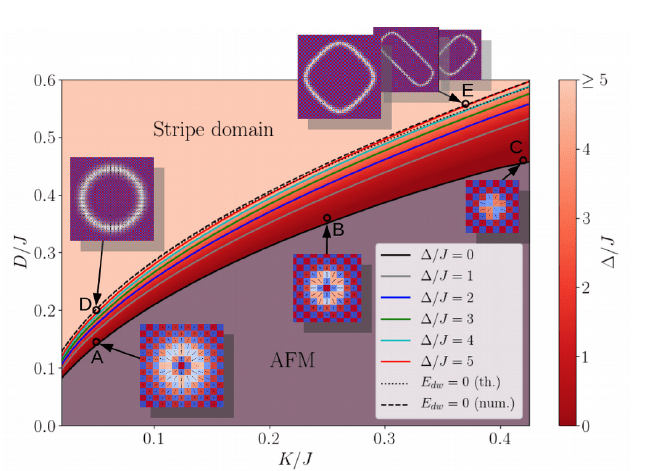
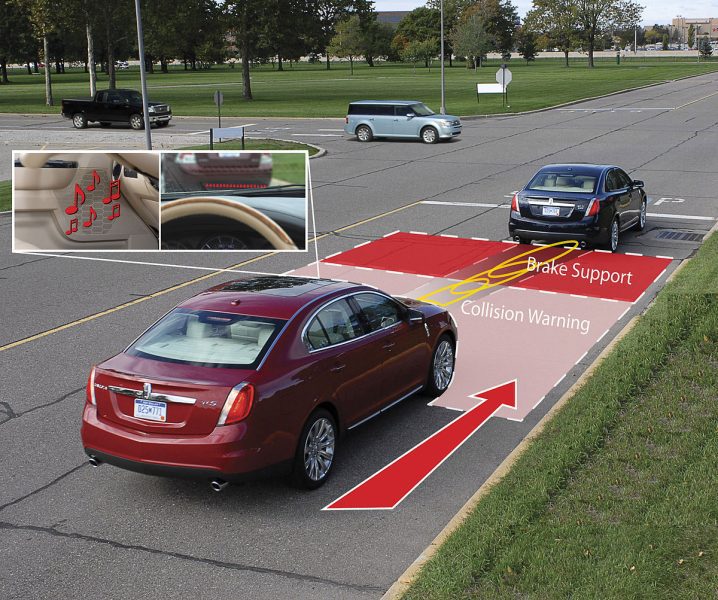
One comment
arturosax
The stopping hour in full format considers it indispensable to watch high-quality cinema, which the free or working day of the week constantly raises. Internet film art has concentrated and